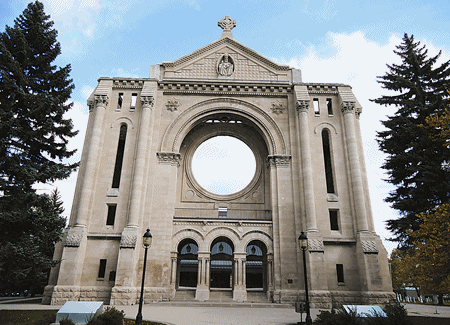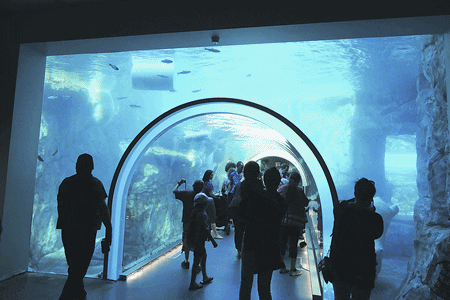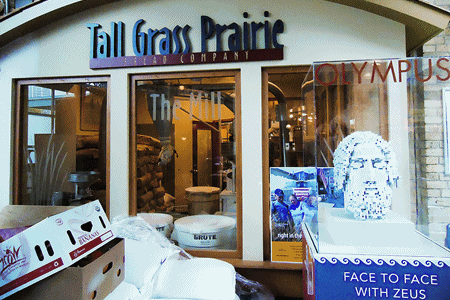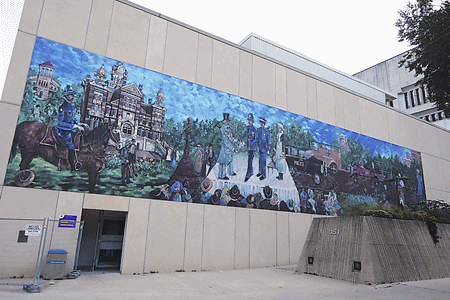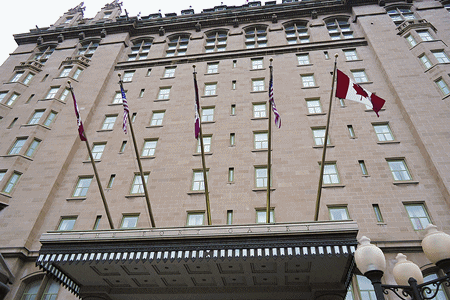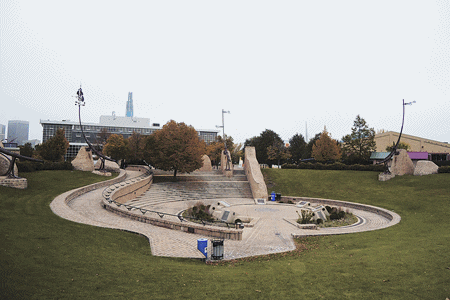Cultural cradle
Winnipeg, the ‘Prairie capital’ known for its history in agricultural economy and the founding of the fur trading post Fort Rouge in 1738, has evolved to become the capital of Manitoba and a vibrant city offering various tourism attractions and activities to visitors interested in history, arts and culture By Kahini Chakraborty
Manitoba, where Canada’s heart beats, is a small treasure trove of untouched natural beauty and urban elegance woven out of historical and cultural incidences. Winnipeg, the capital and largest city of the province, is home to the famous Sir William S Stephenson, the man called ‘Intrepid’, and considered by most people as the real-life inspiration for James Bond. A historical tryst through a guided tour session around the Manitoba Legislative Building on York Street, which has the life-sized bronze statue of Stephenson in military aviator uniform, is a sure treat for all James Bond lovers. Ian Fleming himself once wrote, “James Bond is a highly romanticised version of a true spy. But the real thing is… William S Stephenson.” During the tour, one can get a chance to live through the experiences of the man who was born on January 23, 1987 at Point Douglas, Winnipeg. And if you want some more information, the guides are more than happy to narrate the entire story revealing information about this Canadian soldier, airman, businessman, inventor, spymaster, and a senior representative of British intelligence for the entire western hemisphere during World War II. As head of the British Security Coordination, Stephenson handed over British scientific secrets to Franklin D Roosevelt and relayed American secrets to Winston Churchill. In addition, Stephenson has been credited with changing American public opinion from an isolationist stance to a supportive tendency regarding America’s entry into World War II. Stephenson is also known to have played a key role in the creation of the CIA. It was in 1997 that a new public library was built in Winnipeg which was named after him. On November 15, 2009, Water Avenue in downtown Winnipeg was renamed as William Stephenson Way.
Opposite to this landmark monument is the 77 metres tall Manitoba Legislative Building, that even Dan Brown would be at a loss trying to decipher all the meaning enlaced in this building. This neoclassical building which was completed in 1920 was designed and built by Frank Worthington Simon and Henry Boddington III, along with other masons and skilled craftsmen. The grandiose interior of this ode to Olympus is studded with hieroglyphics, freemasonic symbols and numeric codes. Hence a visit to this building, either through guided or self-guided tour, is a must for travellers interested in history and culture. Known as the Canadian Signature Experience Hermetic Code Tour, the building is famous for the Golden Boy, a gold covered bronze statue based on the style of the Roman god Mercury, or the Greek god Hermes, at the top of the domed ceiling. Each of the four corners of the copper dome supporting the Golden Boy has stonework grouping which represent the four elements of nature-earth, air, fire and water, which are understood as agriculture, science, industry and art. The statue was installed in 1919, originally called as Eternal Youth and sculpted by a Parisian artist, Georges Gardet.
A book was also published in 2007 titled The Hermetic Code by Frank Albo, which describes the details of Masonic and classical history incorporated into the building. Understanding the art and vision behind the construction of this marvellous architecture gets more intense once you enter into the building and come across the Grand Staircase. The staircase has three flights of steps each with 13 steps and is flanked by life size North American bison made of solid bronze. According to legends, the bison is a symbol of the Province of Manitoba, and is meant to represent the sacred bulls which guard temple entrances. Above the south entrance to the legislature lobby is Medusa’s head and over the north entrance facing Medusa is the bust of Athena, the Greek goddess of war and protector of the cities. Around the perimeter of the room are 14 lion heads and eight cattle skulls at the edge of the ceiling. All across the second floor balcony there are lamps that rise from the balustrades, each having 13 bulbs.
In the middle of the Rotunda is an Italian marble balustrade about 13 feet across surrounding the Pool of the Black Star on the floor of the level below, which is a representation of the altars of the ancient Greeks. The diameter of the circle above the balustrade is also 13 feet and both align with the Golden Boy which has been placed on the dome. In the doorway to the Manitoba Assembly is a mural by Frank Brangwyn depicting World War I. The centre of the painting has a man in tattered rags with his left chest and arm exposed, being helped along by a comrade, and above all the men there is a faint depiction of The Madonna and Child. On the level below-the Pool of the Black Star has four entrances and is marked with three steps forming a circumference of the room. The room is circular with a radius of 27 feet. The centre of the floor is an eight pointed black marble star, which is in alignment with the dome of the building on which the Golden Boy is mounted. The design of the building allows sounds from all over the building to be caught and heard in the circular room and the echoes can be heard by speaking in the room.
Tryst with the past
The capital city, Winnipeg, is located near the centre of North America, at the confluence of the Red river and Assiniboine river. The name ‘Winnipeg’ was derived from the western Cree words for Lake Winnipeg, referring to muddy waters. The region was a trading centre for aboriginal people long before the arrival of the Europeans. The city, also known as the ‘Gateway to the West’, is the railway and transportation hub with a diversified economy. Lying at the confluence of the Assiniboine river and Red river of the north, ‘The Forks’, which is now a bustling market, was initially the crossroads of canoe routes which was travelled by First Nations before the European contact. The Forks market was created with the two adjacent horse stables, which were meant for competing rail companies in early 1900s, which was joined together by a courtyard and bridges. This market offers a multitude of shops to browse for a wide variety of specialty items and souvenirs. Near to the market is the Oodena Celebration Circle, which pays homage to the 6,000 years of the aboriginal people in the area. Oodena, Cree for ‘centre of the city’, features ethereal sculptures, a sundial, interpretive signage, a naked eye observatory and a ceremonial fire pit. This makes it an important venue for cultural celebrations. A tour of the Canadian Museum for Human Rights, which has been designed by architect Antione Predock, provides an opportunity for an immersive experience of 11 powerful interactive and inspiring exhibits that can take you on a personal human rights journey looking at Canadian and global issues of the past, present and future. Through these exhibits the museum is looking at fostering dialogue and promoting change for a better world. At the top of the pinnacle is the Tower of Hope which provides a stunning view of the entire city.
The Esplanade Riel and Provencher Bridge have become iconic to Winnipeg and connect the downtown area to Saint-Boniface, the French Quarter. This area has been the home of Franco-Manitobans in the province and has many historic buildings – city hall, fire station and post office. The Saint Boniface Cathedral is the Roman Catholic basilica and an important building in Winnipeg. The basilica, which is in the centre of the city, was the first church founded by Fr Norbert Provencher, a priest and future bishop who ordered the construction in 1818 in the form of a small log chapel. In 1832 Bishop Provencher built the first cathedral but on December 14, 1860, the first building was destroyed by a fire breakout. It was in 1862 that Bishop Alexandre Antonin Tache rebuilt the cathedral in stone. On July 22, 1968, the 1906 cathedral was damaged in a fire, destroying many features including the rose window. Only the facade, sacristy, and the walls of the old church remained. In 1972, a new smaller cathedral was built behind the 1906 facade. Behind the cathedral, a few blocks away is the Le Musée de Saint-Boniface Museum which has many Franco-Manitoban and Metis artifacts. It is also believed that the museum is haunted – visitors have heard sounds of monks chanting, children running and choir of women singing, doors opening and closing along with other paranormal activities. Apart from the museum there are many other locations in Winnipeg which are believed to be haunted, like the famous Fort Garry Hotel’s second floor room 202; The Burton Cummings Theatre; the Art Gallery of Southwestern Manitoba; Elmwood Cemetery; La Barriere Park; Manitoba Legislative Building; Royal Manitoba Theatre Centre and many more.
The other must see attractions in the city include the Winnipeg Art Gallery, Plug In Institute of Contemporary Art, and The Manitoba Museum, which showcases the natural history of Manitoba through life-size displays and artifacts. The Exchange District is one of Canada’s architectural marvels; this 30-block district boasts of North America’s most extensive 20th century buildings. A walk through the city reveals some of its trendiest spots and restaurants, vintage and antique shops and the best it has to offer in coffee and cafe culture. A good example of this is the refurbished Bawlf Block, which was originally built as an office space and is twin to the Benson Block, what is now the Red River College’s bookstore. This was once a commercial space for the building’s early wholesale and retail tenants. After all the walking around the city, you can soak away your stress at the newly opened US$ 11 million Scandinavian-style spa Therrmëa by Nordik Spa-Nature. This luxury spa is open year round, completely surround by nature. Hot and cold pools, saunas and relaxation rooms allow guests to reach true bliss.
–
A trip to Winnipeg cannot be complete until you visit the Assiniboine Park Zoo to do the ‘Journey to Churchill’ tour experience with the much loved polar bears. Watching these majestic mammals dive, swim, and frolic above you through the exhibit’s glass dome will definitely thrill you. The zoo also features uber-rare animals, like red pandas and snow leopards, along with over 200 other species.


